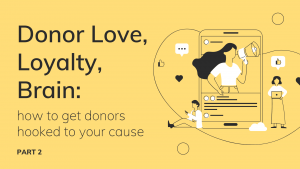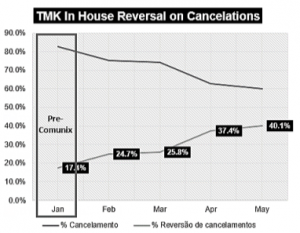Donor Love, Loyalty, Brain: how to get donors hooked on your cause. Part II

In the first article we looked at how to affect better retention and loyalty we need to nudge or influence the memory of supporters through experiences focused on making the first steps human and authentic. According to Kahneman, our memory works on a peak-end form. We remember little: the beginning (as we discussed in the first article), the peaks and the end.
Peaks
Dan and Chip Heat described these peaks of memory as made of ‘elevation’ moments. This means “they provoke not just transient happiness, like laughing at a friend’s joke, but memorable delights.” 4
The sensory part is such an essential part of the way we remember, and how we reconnect to our experience.
When you can make a donor see, touch, hear, or yes, smell your mission and your cause, that’s when you have the greatest chance in terms of his/her attention and propensity to give to create a memorable experience.
3 The article is based on the recently published book Hooked on a Feeling: How the passion and devotion for good causes become memories and identities https://www.amazon.com/Hooked-Feeling-devotion-memories-identities-ebook/dp/B0923717RN
4 Chip and Dan Heat, The Power of Moments (Why Certain Experiences Have Extraordinary Impact Simon & Schuster, 2017
Response with the use of samples in direct mail in UNICEF Italy

In many cases, the sensory part (and the surprise) is because it is connected to an unexpected event (a call, a gift, a gesture). In the examples from UNICEF Italy, for example, the use of an empty dose of polio vaccine or cholera treatment and a sample of fake dirty water boosted the response from donors, especially lapsed donors who had stopped giving.
Celebrations
A second opportunity to create a peak in the memory of your donors comes in moments of celebration. These are special moments that we unexpectedly share or celebrate with for example, a surprise call, some flowers, or even a gift.
One of the most important ways to create a peak or memorable experience is the celebration of a birthday. Charity: Water, for example, grew out of the ground-breaking idea that people could use their birthday to raise money for the organization. In UNICEF we ran a test to see the effect of a birthday call on the lifetime value of donors. We took two identical segments in terms of longevity and type of giving, made one Control, and carried on with it as usual, while the other group only received a longer thank you call and a birthday call.
The simple call to say happy birthday dramatically increased the donors’ loyalty and Lifetime Value. For many donors, especially in the older age
group, the happy birthday call was the only call during the day to celebrate his/her day. Just think of the impact of such a call!
Complaints, or the “demotion” moments
Supporters remember peak moments, both positive and negative, and unfortunately, charities and nonprofits in general are not particularly good at managing negative episodes. It is important, however, to note here that among the many important reasons to deal proactively with complaints is that firstly, the experience of stopping donating, or ‘donor churning’ generally happens not over one episode but after an accumulation of a variety of negative experiences; and secondly, capturing, acknowledging and solving complaints as they arise actually leads to higher retention and engagement.
Complaints from supporters can happen for a variety of reasons (being charged multiple times by mistake on their credit card, being charged the wrong amount; not receiving any or the right information on their donation; not receiving the tax receipt; being over-solicited; being unhappy with the lack of position or the position of the organization on certain issues they care about; etc.).
Acknowledging and dealing with donor’s complaints is a key to creating memorable moments and — as demonstrated by several research and practices — ensuring better and longer-term engagement, retention and loyalty.
Ending
The end of a relationship is never easy. As a matter of fact, nonprofits don’t do much when people stop giving. In fact, they often only notice that you have left after this happens, i.e., because you do not give any more. But our memories (and the chance to recall them to then repeat or set the expectations on our behavior) are based on peaks and ends.
The reality is, however, that an end is never the end. We must try to really understand why a supporter left and, once into an honest dialogue with them, there may well be ways to influence and change their decisions.
You can save the potential or actual cancellation of a donation before the donor actually ‘leaves. Donors cancel or stop their payment for a wide
variety of reasons (change or renewal of card or bank account, temporary lack of cash, etc.). You can discuss it with them and offer a downgrade or decrease (or even upgrade!) in their donation value.
The point is that with a proactive approach, instead of waiting until you get notified can save many donors before they leave! In UNICEF Italy we managed to save 30-40 percent of those who canceled and in Brazil during COVID-19 UNICEF managed to bring up to 40 percent back to donate.

The key to an engaged supporter and advocate for life for your cause has nothing to do with the method of payment or the amount. It has everything to do with what and how our supporters remember their experience with us, and how we can influence those experiences to make it both positive and memorable.

Francesco Ambrogetti, Supporter Engagement Lead, UNICEF International
If you’d like to learn more about donor love – join Francesco at our next Breakfast with the Experts on June 24th - Register today!
